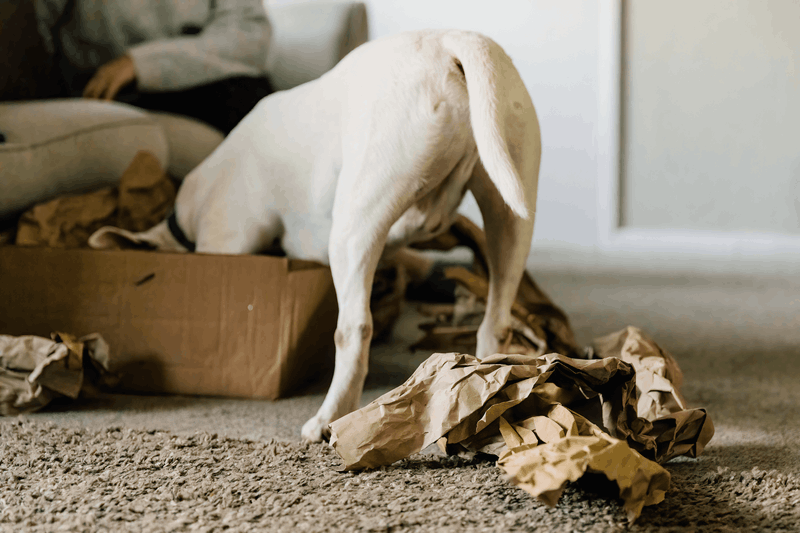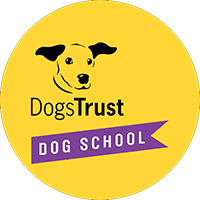Why does my dog dig?
There are lots of reasons why dogs might engage in digging - they might be preparing a cool and comfy resting spot, looking for interesting scents, spreading their own scent, or burying something they want to keep safe.
If your dog is digging somewhere you’d prefer they didn’t, you can prevent your dog from accessing the area. If your dog is digging somewhere in the house, such as your bed, you could use a baby gate, or keep the door closed to prevent access. In the garden, putting up temporary fencing and supervising your dog outside provides a short-term solution. However, you’ll also need to provide them with their very own opportunity to dig safely and teach them how to use the digging area. Otherwise, your dog might find somewhere else inappropriate to dig or become frustrated at not being able to dig at all.
How to make a digging area:
- Select a space in your garden where you’re comfortable with your dog indulging in some digging.
- Get a strong plastic box and remove some of the soil - enough to fill it up.
- Place the filled box in the newly made hole so it’s even with the surface.
Encourage your pooch to enjoy their dedicated digging space, sprinkling favourite treats or part burying their garden toys. If you show interest in the digging space by scratching around it, your dog might come and investigate what you’re doing and copy you! Remember, by using positive reinforcement your dog will want to repeat their actions and keep going back to it.
If they veer away from their digging space, encourage them back by placing rewards there. You can always recall them over to you if they are not interested initially.
If you don’t have a suitable outside space for a digging area, you can create an inside digging box. Get a cardboard box and fill it with ripped up newspaper, with treats and toys hidden in it, so they can seek them out.
For dogs that enjoy nesting in blankets, giving them a selection of their own blankets for their bed can help them learn that it’s much more rewarding digging their bed area than yours.
Should I let my dog chase other dogs?
Some dogs enjoy chasing things or being chased themselves. For these dogs, incorporating chase into your games by using toys they can safely chase in enclosed spaces, can provide an appropriate and fun outlet for their desire to play chase. You could plan a meet up with a friend or family members’ pooch if they also enjoy chase! You can find out more about appropriate play for your furry friend in our video.
However, chasing can be incredibly dangerous should a dog give chase to traffic or livestock for example. It’s important to remember that chasing is a natural behaviour, so all dogs can chase no matter what their breed. Dogs should always be kept on leads where traffic and livestock are present. If you know that your dog is likely to become frustrated in these situations, and might bark or pull on the lead, then choose different and quieter walking routes to avoid the triggers in the short term. You can then help your dog to learn alternative, more appropriate, behaviours in these situations, such as paying attention to you and walking on a loose lead and gradually reintroduce busier walking routes when your pooch is equipped with the skills to manage in the environment.
Dogs that enjoy being chased can also learn to run away with items if their owner immediately runs after them as a result. Keeping your prized belongings out of your dog’s reach in the first place will reduce the chance of them getting hold of something they shouldn’t. If they do get hold of something, try to avoid chasing your dog or giving them any direct attention, because this may encourage your dog to repeat the behaviour. If you need to calmly interrupt your dog, create a distraction elsewhere such as opening a door or rummaging. You can then engage your dog in something more appropriate. If your dog gets hold of something that could be dangerous and you can’t ignore or distract them, then swap the item for something else that is rewarding for the dog such as their favourite tasty treat.
If your dog is chasing their tail repeatedly, or hurting themselves, consult your vet immediately to rule out a medical reason for this behaviour.
Top Tip: Practice calling your dog over to you, even when exciting things are happening, such as playing chase with their puppy pals!
Why does my dog chew and should I stop them?
Dogs use their mouths to help them explore and learn about their surroundings. Chewing and licking is also a way of transferring their own scent to their environment, which is another form of canine communication.
Just how much a dog enjoys chewing is completely individual - many dogs will chew and shred their toys readily, while other dogs will have unchewed, intact toys for years. It can also be a pleasurable and relieving activity, particularly for puppies when they are teething and might have sore mouths. However, as dogs like to chew, sometimes they may chew things that belong to us or items that are dangerous for them.
Chewing is a natural behaviour for dogs, so it’s important to provide your dog with lots of safe items they can chew otherwise they might gnaw something you would really prefer they didn’t! Careful management and providing a wide range of appropriate toys and chews can help your dog learn what is right to chew. Make sure you praise your dog for chewing on their own items!
If you are concerned about your dog’s chewing, seek professional support to help you understand how your dog is feeling, and why they might be engaging in this behaviour.
How do I stop my dog from barking?
Barking and other vocalisations, such as howling and whining, are all part of normal dog communication. Broadly speaking, dogs bark either in positive anticipation or to prevent something they feel is bad from happening. If your dog is barking frequently or for long periods of time, it can be as much of a problem for your dog as it is for you, or your neighbours! It’s important to act early to help prevent your dog’s barking from developing into something more serious.
The key to reducing and preventing unwanted barking is to understand why your dog is barking in the first place. When you learn what your dog hopes to gain from barking, you can show them that they can get what they want by behaving in a calmer, quieter way. You may also be able to make changes to your dog’s living space, so they no longer feel the need to bark.


